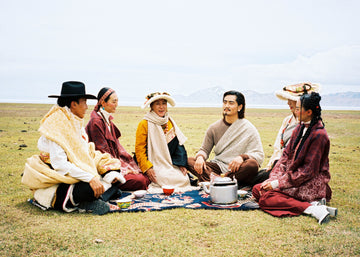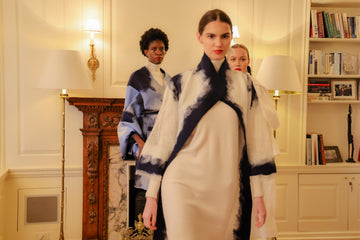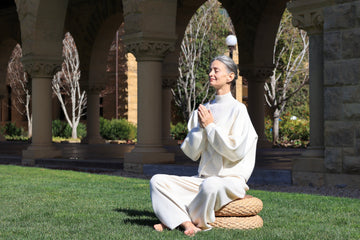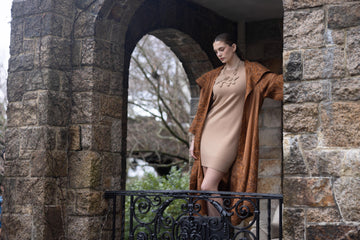In January 2020, I am going to present Sandriver’s cashmere felt handmade collection to buyers from all over the world during the tradeshow Maison & Objet Paris.
This will be the first public launch of my work after 8 years’ research. Maison & Objet Paris was chosen to be the place.
Wool felt craftsmanship is a traditional handicraft that has been passed down over more than 1000 years in Inner Mongolia. I have many wonderful souvenirs of my childhood, as my family moved around according to nomadic tradition, setting up our yurts on the steppe or near lakes. The yurt, furnished with wool felt was our refuge during the winter! The image of making wool felt objects with my family is still vivid in my memory.
Today, the Mongol people have adopted a sedentary lifestyle. As a result, wool felt craft production is disappearing, and few people still practice this skill. I hope to bring this memory to life again, to continue this traditional craftsmanship and innovate by using top cashmere material to develop artworks.

Over the past 8 years, I have spent a lot of time doing research on the core techniques of wool felt, from the initial conception to the final realisation of cashmere felt handmade artworks. In addition, I have studied the features of cashmere material, and its different character when combined with silk or lace, either through knitting or weaving. This is an innovation, or more like a revolution for the Mongol wool felt crafts; I have transformed my memory of traditional styles into high-quality cashmere handmade artworks with a modern design.
The new collection is 100% handmade, without the use of any tools. They are akin to sculptural artworks with colourful cashmere fibres. Our craftsmen are like plastic artists using their two hands to give cashmere materials a shape, a life. This is not a manufacturing process; it is an artistic creation process. Every piece is unique!
This is a breakthrough in traditional wool felt craftsmanship in Inner Mongolia. The uniqueness of the creation process makes cashmere works more noble and exclusive.

One memory is still vivid; 8 years ago in Japan, our creative director showed me a piece of her collection from Inner Mongolia, a 100% handmade cloak. I was impressed by the finishing of this piece, the details were so refined, you can imagine the serenity, in which the craftsmen who made this piece of cloak, worked.
I was so moved by this piece of her collection. As a descendant of the Inner Mongolia steppe, however, I had forgotten about wool felt crafts. I began to feel ashamed after this encounter with the cloak.
This craftwork became my obsession, although 8 years ago I had no idea how to proceed. Nobody used soft gold cashmere to experiment in artistic creation, and I could not initiate my innovative cashmere technique. Our ancestors did not show us the path, but did offer the inspiration. How should we work on this inspiration?
There is no ready answer, we can only try and experiment to grow this seed of cashmere innovation.
I am quite a stubborn woman, maybe a result of having worked in Germany for 2 years. Once I set a goal, I don’t give up until it is attained.
Today I am full of emotion in preparing to launch the cashmere artworks in January 2020 and present the collection to the world. It is my biggest salute to my homeland, the steppe of Inner Mongolia, a land full of spirituality.
I proved that I could cross the path, climb the mountain and find a way to realise the inspiration and to present it to the world.

I remember the resistance and the doubt encountered along my journey. Who would be mad enough to go back to the craftsmen era from the modern industrial period? Who would hold onto a memory and take it as a reason to persist?
People have time to spend on social media, but no time to listen to dreams. My passion pushed me to meet with senior herdsmen, to meet my relatives who still live on the steppe, and to meet overseas artists and young crafts fans. They all have wool felting skills, but know little about cashmere. This crazy dreamer of cashmere sculpture has been exploring and experimenting all possibilities over the last 8 years, exactly 8 years up to 29 November 2019.
I have mobilised the whole production chain of the textile sector to redefine a new category. This new category integrates the various forms of cashmere, a mix of different materials, a combination of a range of techniques to work cashmere such as by knitting and weaving. When an Italian senior professional saw the different gestures our craftsmen used on a piece of cashmere work with French lace accessories, he was so surprised, he said “Are these gestures not used in the Chinese kitchen? How could these gestures be used in our sector?”
Lots of professional buyers could not understand our works when they first saw them.
It is not easy to understand, it is mysterious, it is from a distant land, it originated from the steppe, it is also a heritage of the Mongol people to the world, simple but timeless.
I am so lucky to be able to benefit from this heritage and pass this it on to others.
Thank Tengri, the god of the steppe.






